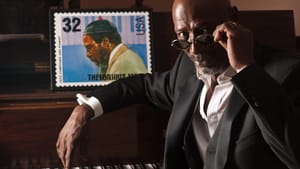Stay in the Loop
BSR publishes on a weekly schedule, with an email newsletter every Wednesday and Thursday morning. There’s no paywall, and subscribing is always free.
The legend lives on
Annenberg Center Live presents T.S. Monk

Father-son relationships are routinely fraught with tension and even outright rebellion. The dynamic between Thelonious Sphere Monk II and Thelonious Sphere Monk III — who made his Annenberg Center debut last week — was no exception.
The younger Monk, whose professional name is T.S. Monk, grew up among jazz royalty and received his first drum lessons from no less than Max Roach. Monk performed with his father for several years, but after the elder Monk’s retirement in 1975, he turned to R&B, only to return to jazz after his father's 1982 death.
Polished sound
But if there was ever any dissension between father and son, it didn’t show at this loving musical tribute. Playing without an intermission, Monk’s sextet, with Monk leading from the drum set, played invigorating arrangements of his father’s hits, plus Wayne Shorter’s “One by One,” and T.S. Monk’s love song to his daughter, “Sierre.”
Those numbers sound highly influenced by the elder Monk, displaying strong melodic content. They also held the quirky rhythmic sensibility for which Monk was so well known (and also ridiculed: one critic said his playing sounded like he had two left arms).
T.S. Monk defies the stereotypical persona of a drummer when he performs; his playing is largely free of flashy pyrotechnics and is dynamically nuanced. This profile carries through in his band leadership, setting measured pacing and a generally conservative demeanor.
Unlike most musicians in the elder Monk’s generation, these are academically trained players (at least two teach in conservatories), so this ensemble was more polished than fiery. Randall Haywood’s trumpet had a bright, Freddy-Hubbard-like sassiness, and Willie Williams threw out a fluid, elegant sound on his tenor sax.
Haywood’s alto-sax counterpart, veteran sideman Joe Hill, was also smooth, if a bit tired-sounding. Theo Hill played keyboard, Monk père’s instrument, producing sweeping streams of notes. Wisely, he did not attempt to imitate the inimitable giant. At the backbone of the ensemble was bass player Chris Berger, lending the entire session a smart, propulsive inner energy.
One and only
The concert concluded with three selections accompanied by vocalist April May Webb, a young powerhouse of a singer with a huge range and vibrant tone. However, I’d describe her style as overly stylized. Webb loves to scat, perhaps too much, and thrills her audience with big, swooping sound that jumps over several octaves.
Pulling back a bit on the showboating can only make her a more refined artist, especially given her superb technique. Her crystal-clear diction hearkens back to the great jazz divas (Sarah Vaughn comes notably to mind).
Webb and the band closed the show with an up-tempo rendition of “'Round Midnight,” with all the players performing a final set of solos. Then Monk took the opportunity to make a final boast about his father.
Thelonius Monk is one of the most performed jazz composers in history, second only to Duke Ellington. But he beats Duke in a significant category: “‘Round Midnight” is the most performed jazz standard of all time, appearing on more than 1,000 albums since it was written in 1944.
What, When, Where
T.S. Monk. November 3, 2018, at the Annenberg Center's Zellerbach Theater, 3680 Walnut Street. (215) 898-3900 or annenbergcenter.org.
Sign up for our newsletter
All of the week's new articles, all in one place. Sign up for the free weekly BSR newsletters, and don't miss a conversation.
